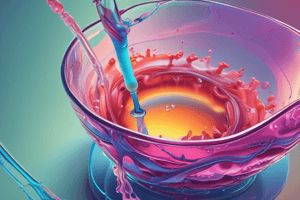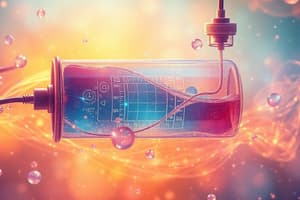Podcast
Questions and Answers
What are the two main fluid groups described in the text?
What are the two main fluid groups described in the text?
Crystalloids and colloids
How does IV fluid distribute to the body compartments?
How does IV fluid distribute to the body compartments?
IV fluids distribute to intracellular and extracellular compartments
What are the three usual reasons for giving fluids as mentioned in the text?
What are the three usual reasons for giving fluids as mentioned in the text?
Resuscitation, Replacement, Maintenance
What are the two types of physiological losses mentioned in the text?
What are the two types of physiological losses mentioned in the text?
What is the total body water composition in the human body according to the text?
What is the total body water composition in the human body according to the text?
What are the four fluid and electrolyte compartments mentioned in the text?
What are the four fluid and electrolyte compartments mentioned in the text?
What are the general requirements for assessing fluid needs in health?
What are the general requirements for assessing fluid needs in health?
What are the constituents and their amounts required for oral intake in health?
What are the constituents and their amounts required for oral intake in health?
What are the plasma electrolyte levels for Sodium, Potassium, Chloride, and Osmolarity in health?
What are the plasma electrolyte levels for Sodium, Potassium, Chloride, and Osmolarity in health?
What are the signs of hypovolaemia?
What are the signs of hypovolaemia?
What are the signs of hypervolaemia or fluid overload?
What are the signs of hypervolaemia or fluid overload?
What are the major types of pathological losses to consider in assessing fluid needs?
What are the major types of pathological losses to consider in assessing fluid needs?
What are the components and amounts of bodily fluid losses in mmol/L for gastric juice/vomit, biliary drain, jejunal loss, ileal fluid, and diarrhea/colostomy?
What are the components and amounts of bodily fluid losses in mmol/L for gastric juice/vomit, biliary drain, jejunal loss, ileal fluid, and diarrhea/colostomy?
What are the main characteristics of crystalloids?
What are the main characteristics of crystalloids?
What is the fluid distribution in the intracellular and extracellular compartments?
What is the fluid distribution in the intracellular and extracellular compartments?
What are the components of 0.9% sodium chloride fluid?
What are the components of 0.9% sodium chloride fluid?
What are the two main fluid groups described in the text?
What are the two main fluid groups described in the text?
What is the total body water composition in the human body according to the text?
What is the total body water composition in the human body according to the text?
What are the characteristics of the two main fluid groups crystalloids and colloids?
What are the characteristics of the two main fluid groups crystalloids and colloids?
What are the three usual reasons for giving fluids as mentioned in the text?
What are the three usual reasons for giving fluids as mentioned in the text?
What are the fluid and electrolyte compartments mentioned in the text?
What are the fluid and electrolyte compartments mentioned in the text?
What is the usual fluid requirement for health?
What is the usual fluid requirement for health?
What are the general requirements for assessing fluid needs in health?
What are the general requirements for assessing fluid needs in health?
What are the plasma electrolyte levels for Sodium, Potassium, Chloride, and Osmolarity in health?
What are the plasma electrolyte levels for Sodium, Potassium, Chloride, and Osmolarity in health?
What are the signs of hypovolaemia?
What are the signs of hypovolaemia?
What are the two main fluid groups described in the text?
What are the two main fluid groups described in the text?
What are the signs of hypervolaemia or fluid overload?
What are the signs of hypervolaemia or fluid overload?
What are the main characteristics of colloids?
What are the main characteristics of colloids?
What is the constituent amount of water required for oral intake in health?
What is the constituent amount of water required for oral intake in health?
What type of fluid is 5% dextrose /0.9% sodium chloride?
What type of fluid is 5% dextrose /0.9% sodium chloride?
What are the components of 5% dextrose /0.9% sodium chloride fluid?
What are the components of 5% dextrose /0.9% sodium chloride fluid?
What are the main reasons for giving fluids as mentioned in the text?
What are the main reasons for giving fluids as mentioned in the text?
Flashcards are hidden until you start studying




